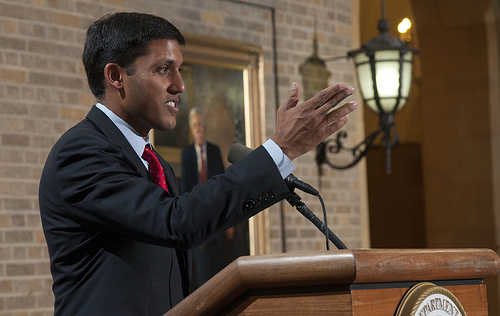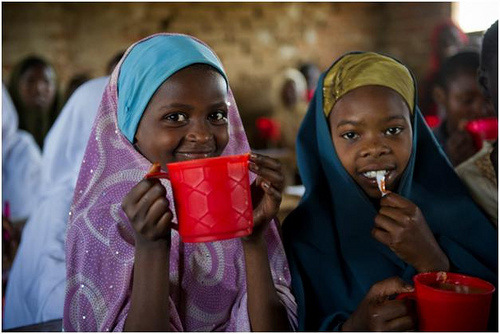
Researchers in Njoro, Kenya, evaluating wheat for resistance to Ug99 in October 2005.
The Journal Nature today published a paper reporting that scientists from USDA’s Agricultural Research Service (ARS), as part of an international team, have completed a shotgun sequencing of the wheat genome. The achievement is expected to increase wheat yields, help feed the world and speed up development of wheat varieties with enhanced nutritional value. Wheat is one of the world’s “big three” crops, along with rice and corn, upon which the world’s growing population depends for nutrition.
Sequencing the genome of wheat was unusually daunting because the wheat genome is five times the size of the human genome, and has 94,000 to 96,000 genes. This sequencing effort involved the identification of essentially all of those genes and mapping their relationship to other genes. Previously, the size and complexity of the wheat genome had been significant barriers to performing a complete analysis, but the scientists overcame that problem by developing a new strategy that compared wheat genetic sequences to known grass genes, such as from rice and barley. Read more »
On October 16, World Food Day, it is hard to not be struck by how lucky we are in the United States. We have abundant food that costs us less to produce, on a per unit basis, than almost any other country in the world. Our farmers and ranchers produce more than we need, allowing us to be a powerhouse in global exports. And our food supply is among the safest of all the world’s nations.
All that abundance and security has been underpinned by science and know-how. Between the 1940s and the 1970s, agriculture science blossomed in what has become known as the Green Revolution. Thanks to the research done by Norman Borlaug, the “Father of the Green Revolution,” working with researchers around the world, developed high-yielding varieties and modern production practices that helped save untold numbers of people from starvation. Read more »

A Bangladeshi factory worker monitors the production of biscuits made from U.S. donated wheat. The donation was delivered to the World Food Programme, a Foreign Agricultural Service (FAS) McGovern-Dole program participant that works to provide food assistance in more than 73 countries. The biscuits will be distributed to about 2,000 schools in the poorest areas of Bangladesh. (Photo courtesy U.S. Embassy New Dehli)
Approximately 350,000 school children in Bangladesh now have access to a daily snack after the U.S. government recently donated more than 10,000 metric tons of wheat to the country through the Foreign Agricultural Service’s (FAS) McGovern-Dole Food for Education Program. Read more »
Tags: Bangladesh, Dan W. Mozena, FAS, Feed the Future, Food Security, George McGovern, McGovern-Dole Food for Education Program, President Obama, Trade, World Food Prgoramme
 Food Security, International, Trade
Food Security, International, Trade
As summer break winds down, children around the world prepare for a new school year. But for some children, going to school is more than making new friends and learning new subjects; it’s an opportunity to eat a full, nutritious meal.
The Foreign Agricultural Service’s (FAS) McGovern-Dole Food for Education Program helps provide these meals to children in low-income, food-deficit countries that are committed to universal education. The program aligns with President Obama’s Feed the Future initiative and has helped feed millions of children over the years. One example of the success of this program can be found in the Republic of Congo, where the undernourishment rate of children is estimated at nearly 35 percent of the population.
Since 2001, FAS has implemented four McGovern-Dole Programs in Congo through the non-profit organization, International Partnership for Human Development (IPHD). During this time, IPHD distributed about 30,000 metric tons of U.S.-donated foods (rice, beans, potato flakes and vegetable oil) to nearly 150,000 pre-school and primary school-age Congolese children. IPHD also supported school infrastructure, parent-teacher associations and children’s health needs. Read more »
This week, USDA was honored to join forces with USAID and Islamic Relief USA to host the department’s 4th annual Iftar celebration. The event welcomed over 170 guests, including representatives from humanitarian organizations, faith-based groups and federal employees. This year’s Iftar called attention to the importance of reducing food insecurity abroad with the theme “Feed the Future: Together We Can.” Iftar is an evening gathering held each year during Ramadan. A time of spiritual cleansing in the Islamic faith, Ramadan is when Muslims fast, abstaining from food and water from sunrise until sunset. Iftar is the meal at which Muslims break their fast each night. For many Muslims, fasting is an act of empathy towards those around the world who go hungry not by choice, but instead by circumstance.

USAID Administrator, Dr. Rajiv Shah, speaks about Feed the Future
Read more »

Consumers in low-income countries on average spend half their income on food, leaving little or no money to spend on other goods and services. As the world population grows, agricultural science will play an important role in helping us combat hunger and malnutrition around the globe. (photo courtesy of the World Food Program/Rein Skullerud)
This post is part of the Science Tuesday feature series on the USDA blog. Check back each week as we showcase stories and news from the USDA’s rich science and research portfolio.
The world is not merely facing a challenge of sustainably producing enough food to feed a world whose population will exceed 9 billion by 2050, but also confronting the continuous challenge of ensuring that nutritious and safe food reaches needy families, so that every child can have a safe and healthy childhood. Combating this urgent crisis requires a global collaborative effort. According to experts, by 2050 agricultural production will need to increase by 70% to meet increased demand for food, diet changes and additional demand for industrial uses for plants. To help meet this goal, USDA has developed a Global Food Security strategy, focused on research, development, education and extension. As part of USDA’s Office of the Chief Scientist series of white papers on USDA’s research portfolio, this plan aligns USDA’s food security research with the goals of President Obama’s Global Food Security Initiative, Feed the Future. Read more »




